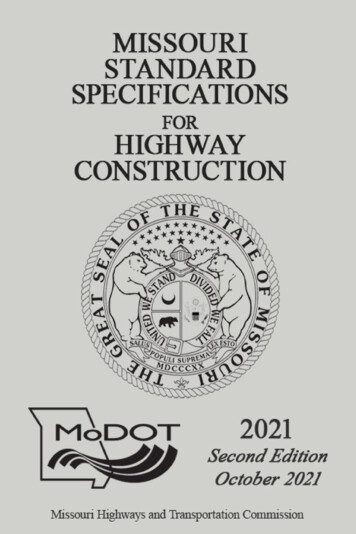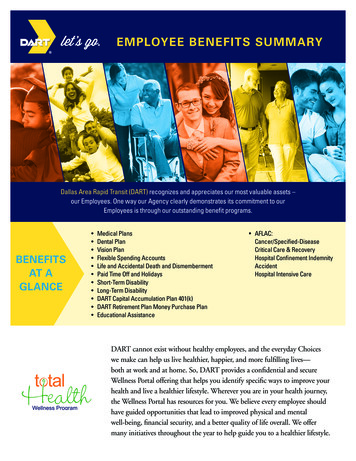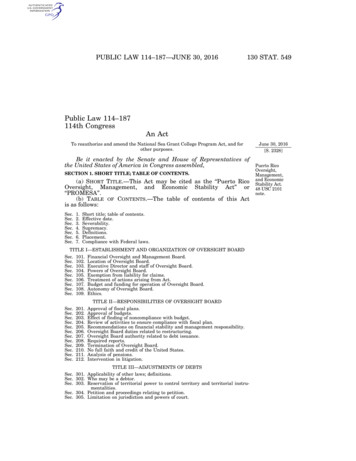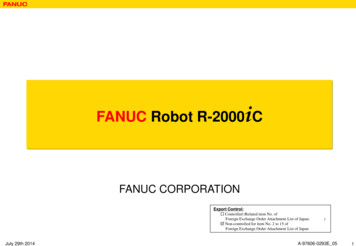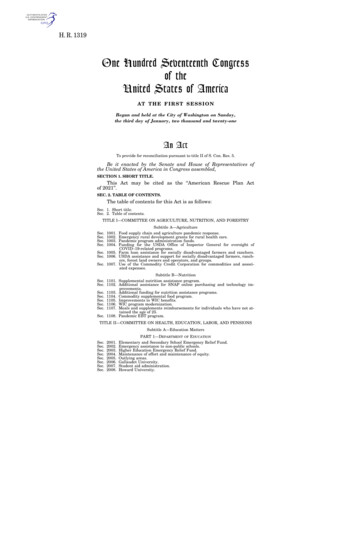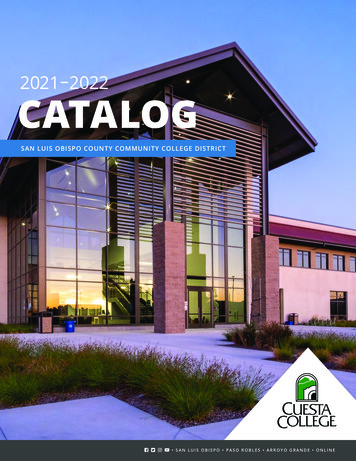
Transcription
Appendix IIIAudit of SEC’s EmployeeRecognition Program andRecruitment, Relocation, andRetention IncentivesAugust 2, 2011Report No. 492SEC Employee Recognition Program and 3R IncentivesReport No. 492Page 1August 2, 2011
UNITED STA TESSECURITIES AND EXCHANGE CO MM ISSIONWA SHINGTON , D . C .20549OFFICE O FI NSPECTOR GENERA LMEMORANDUMAugust 2, 2011To:Cristin Fair, Acting Associate Executive Director, Office of HumanResourcesKenneth A. Johnson, Chief Financial Officer, Office of FinancialManagement (OFM)From:H. David Kotz, Inspector General, Office of Inspector General (OI W WSubject:Audit of SEC's Employee Recognition Program and Recruitment,Relocation, and Retention Incentives, Report No. 492This memorandum transmits the U.S . Securities and Exchange CommissionOIG's final report detailing the results on our audit of the SEC's employeerecognition program and recruitment , relocation and retention incentives. Thisaudit was conducted as part of our continuous effort to assess management ofthe Commission's programs and operations and as a part of our annual auditplan.The final report contains 14 recommendations which if fully implemented shouldenhance the Commission 's employee recognition program and administration ofrecruitment , relocation and retention incentives. The respective officesconcurred with all 14 of the report's recommendations. Your written response tothe draft report is included in Appendix V.Within the next 45 days, please provide the OIG with a written corrective actionplan that is designed to address the recommendations. The corrective actionplan should include information such as the responsible official/point of contact,timeframes for completing required actions, and milestones identifying how youwill address the recommendations.Employee Recognition Program and 3R IncentivesReport No. 492Page iiEmployee Recognition Program and 3R IncentivesReport No. 492Page iiAugust 2, 2011August 2, 2011
Should you have any questions regarding this report, please do not hesitate tocontact me. We appreciate the courtesy and cooperation that you and your staffextended to our auditors during this audit.Attachmentcc:James R. Burns, Deputy Chief of Staff, Office of the ChairmanLuis A. Aguilar, CommissionerTroy A. Paredes, CommissionerElisse B. Walter, CommissionerKathleen L. Casey, CommissionerJeff Heslop, Chief Operating Officer, Office of Chief of OperationsDiana Davis, Business Manager, OHRRebecca Pikofsky, Assistant Director, Employee and LaborRelations, OHREmployee Recognition Program and 3R IncentivesReport No. 492Page iiiAugust 2, 2011
Audit of SEC’s Employee RecognitionProgram and Recruitment, Relocation, andRetention IncentivesExecutive SummaryBackground. The Securities and Exchange Commission’s (SEC orCommission) Employee Recognition Program (ERP) is designed to motivateemployees and recognize contributions above and beyond normal jobrequirements with monetary and nonmonetary awards and to improve theefficiency of operations through an employee suggestion program. Awards maybe granted for contributions either within or outside an employee’s jobresponsibilities.The Office of Human Resources (OHR) has authority for managing theCommission’s awards budget and granting final approval of awards. OHR is alsoresponsible for training supervisors to use the ERP effectively to achieveorganizational goals and objectives, providing guidelines for initiatingappropriately selected performance-related awards, encouraging employees tosubmit suggestions to the suggestion program, and evaluating and processingawards and suggestions. Further, OHR is responsible for monitoring andevaluating the adequacy of documentation for award recommendations and theuse of approval authority that is delegated to divisions and offices.During the period covered by this Office of Inspector General (OIG) audit, fiscalyears 2008 through 2010, the Commission permitted monetary recognition in theform of special act or service awards, suggestion awards, time-off awards, 1 andon-the-spot awards. The Commission also utilized recruitment, relocation, andretention incentives. Recruitment, relocation, and retention (3R) incentives areamong the human capital flexibilities intended to help federal agencies addresshuman capital challenges and to build and maintain a high-performing workforcewith essential skills and competencies.Objectives. The overall objective of this audit was to assess whether monetaryawards under the SEC’s ERP and 3R incentives were awarded consistent withapplicable governing policies and procedures. We also examined whetherawards and incentives were linked to the Commission’s human capital plan, asapplicable.Results. In this audit, the OIG found that OHR has not fully implementedrecommendations made as a result of a 2007 Office of Personnel Management1Time-off awards are considered monetary awards because they have monetary value in termsof lost production time to the Commission.Employee Recognition Program and 3R IncentivesReport No. 492Page ivAugust 2, 2011
(OPM) human resources operations audit pertaining to the SEC’s awardactivities. As a result, we found that similar deficiencies continue to exist. Forexample, we found that there were insufficient resources dedicated to developingand overseeing the ERP and there was a lack of documentary support forsampled awards. We also identified significant time lags between special actdates and award dates due to award budget allocations being made late in thefiscal year.The audit also found that OHR does not have updated comprehensive policiesand procedures available to its supervisors and employees regarding SECawards and 3R incentives. Additionally, OHR has not provided supervisors andemployees with formal training in this area. As a result, the Commission’s use ofawards and incentives is not as effective as it could be in achieving intendedgoals.Further, we found that the SEC’s budgeting processes for awards and incentivesfor SK 2 employees are flawed and ineffective. The SEC’s overall award budgetfor SK staff and average award per person are nominal. Additionally, SECoffices and divisions often are not notified of their award budgets until late in thefiscal year, which has resulted in awards being made significantly after therewarded action occurred. Further, during the period covered by our audit,supervisors were able to use their award budgets only for special act awards,virtually eliminating their ability to reward employees for outstanding performancein the course of their normal job duties and contrary to one of the primarypurposes of the ERP. We also found inconsistencies among offices anddivisions with respect to their adherence to the terms of the budget allocationmemoranda issued to divisions and offices, including instances in which officesexceeded their award budgets or provided awards in advance of receiving theiraward budgets. We determined that payment of awards at the end of the fiscalyear presents various accounting issues, including payroll errors. Lastly, wefound that although Office Heads and Division Directors are ultimately notified oftheir awards budget, they are not notified of funds available for 3R incentives.Furthermore, we found that OHR’s supporting documentation for a large numberof the monetary awards and incentives reviewed for this audit were incomplete.We found that documentation was insufficient to show the basis for the awardsand incentives and that required approvals were properly obtained. We alsofound that an SEC employee was given an award for work that was the subject ofan OIG investigative report. Although the SEC postponed giving the awardpending a determination of whether disciplinary action was warranted against theemployee, the award was eventually granted after an outside consultantdetermined that the employee’s actions did not warrant formal disciplinary action,even though the outside consultant did not dispute the serious performanceissues pertaining to the employee raised in the OIG report.2SK is a staff level pay scale used by the SEC in lieu of the GS pay scale.Employee Recognition Program and 3R IncentivesReport No. 492Page vAugust 2, 2011
Additionally, we found that the SEC made a cash award to an SEC Schedule Cemployee in fiscal year 2010 in violation of OPM guidance restricting awards,bonuses, and similar payments for political appointees.The audit also found that although OHR had an Employee Suggestion Programin place from 2008 to 2011 that included a monetary incentive component, OHRdid not make any cash awards under the program. Additionally, the program wasgiven little priority and was not effectively managed.Lastly, we found that the SEC does not currently have in place a human capitalplan. Accordingly, activities associated with the ERP and 3R incentives are notbeing assessed to determine whether they effectively align with the SEC’s overallhuman capital goals and objectives.Summary of Recommendations: Specifically, the OIG recommends that theOffice of Human Resources:(1) Implement an internal review process to review a select number orpercentage of awards annually to ensure that appropriate documentationexists for the awards and needed information is readily available to supportthe awards.(2) Annually provide information to SEC supervisors on relevant parts of theSEC award program, including (1) types of awards available and proceduresfor nominating employees for awards, (2) appropriate types of division-andoffice-level awards for peer recognition, and (3) successful award practices.(3) Dedicate specific resources to develop and oversee the EmployeeRecognition Program.(4) Finalize its policies and procedures for the Employee Recognition Programwithin three months and publish them on the SEC’s Insider. The policiesand procedures should include information on current practices fordetermining bonuses for Senior Officers (SO), policies for determiningperformance-based awards for SK employees, and acceptable methods ofproviding informal nonmonetary awards in addition to traditionalnonmonetary awards.(5) Review and update its existing policies and procedures on recruitment,relocation, and retention incentives. The update should ensure that the newpolicies and procedures reflect appropriate references to SK and SOemployees and include expanded authority for retention bonuses.Employee Recognition Program and 3R IncentivesReport No. 492Page viAugust 2, 2011
(6) Provide formal training on its revised policies and procedures and issueinformation notices to supervisors and employees as needed to reflectchanges in practices and policies.(7) In conjunction with the Office of Financial Management (OFM), take thefollowing actions:7a. Develop alternatives for reviewing the SEC awardbudget so that it is competitive with other federalagencies’ award budgets.7b. Develop and implement a mechanism to rewardemployees for superior or meritorious performance withintheir job responsibilities through lump-sum performanceawards.7c. Determine ways to reduce the time required forformulation of budget allocations, including, for example,moving responsibility for formulating award budgetallocations to OFM and having the Office of InformationTechnology walk-in development center develop anelectronic program to pull payroll data directly from theDepartment of the Interior to facilitate more timelycompletion of budget allocations.7d. Implement a process to make initial award allocations inthe first quarter of each fiscal year, thereby giving officesthe ability to make awards throughout the year. Baseinitial allocations on historical data and then refine theallocations, as needed, when the SEC’s annual budgethas been approved.7e. Allocate award funds directly to SEC divisions andoffices instead of placing the initial award funds in OHR’sbudget, and hold office and division heads responsiblefor monitoring use of the funds.7f. Re-examine budgeted amounts for recruitment, relocation, andretention incentives to ensure that sufficient funds are available, andmake supervisors aware of available funding so that they caneffectively use incentives to recruit and retain needed talent(8) Develop and train human resources specialists on a centralized filing system(manual, electronic, or both) for all awards that contains appropriatedocumentation to support the awards, including SF 50 and SEC Form 48with narrative justification and appropriate approvals.Employee Recognition Program and 3R IncentivesReport No. 492Page viiAugust 2, 2011
(9) Implement management controls to ensure that employees who are subjectto disciplinary action are restricted from receiving awards related to theperformance that resulted in the disciplinary action.(10) Review the August 12, 2010, cash award to a Schedule C employee todetermine whether it was in violation of the OPM guidance and, if so, seekrecovery of the improper award.(11) Consider ways that, as part of the ERP, it may be able to provide awards toemployees for adopted suggestions submitted to the OIG’s suggestionprogram.(12) Revise the service agreement format in SEC Form 2299, Securities andExchange Commission Recruitment Bonus Service Agreement, toincorporate specific reasons that the SEC “may” and “must” terminateservice agreements for recruitment and relocation bonuses.(13) Develop and train applicable human resources specialists on the use of acentralized filing system for all relocation, recruitment, and retentionincentives. The centralized filing system should contain all appropriatedocumentation to support the incentives, including the SF 50 and theapplicable SEC form with the narrative justification for the bonus and theappropriate approvals.(14) Identify resources and establish a timeline to complete the required humancapital plan. Ensure that ERP activities are evaluated at least annually toensure that they align with human capital plan objectives and strategies.Employee Recognition Program and 3R IncentivesReport No. 492Page viiiAugust 2, 2011
TABLE OF CONTENTSExecutive Summary . ivTable of Contents . ixBackground and Objectives . 1Background . 1Objectives . 3Findings and Recommendations . 4Finding 1: OHR Did Not Fully Address OPM RecommendationsPertaining to SEC Award Practices . 4Recommendation 1. 7Recommendation 2. 7Recommendation 3. 8Finding 2: OHR’s Policy for Its Award Program Is Outdated and NotReadily Accessible . 8Recommendation 4. 11Recommendation 5. 11Recommendation 6. 11Finding 3: OHR’s Budgeting Processes for Awards and Incentives AreIneffective . 12Recommendation 7. 16Finding 4: OHR Did Not Maintain Adequate Documentation to Support SKAwards Made During Fiscal Years 2008 Through 2010 . 17Recommendation 8. 22Recommendation 9. 22Finding 5: A Cash Award Was Inappropriately Made to a Schedule CPolitical Appointee. 22Recommendation 10. 23Finding 6: OHR’s Employee Suggestion Program Did Not Provide CashAwards During Fiscal Years 2008 Through 2010 and Was Not EffectivelyManaged . 23Recommendation 11. 26Employee Recognition Program and 3R IncentivesReport No. 492Page ixAugust 2, 2011
Finding 7: OHR Does Not Maintain Adequate Documentation for 3RIncentive Awards, and Related Service Agreements Do Not Meet OPMRequirements . 26Recommendation 12. 31Recommendation 13. 31Finding 8: The SEC’s ERP and 3R Incentives Are Not Linked to an SECHuman Capital Plan . 32Recommendation 14. 33AppendicesAppendix I: Abbreviations/Acronyms. . 34Appendix II: Scope and Methodology. 35Appendix III: Criteria . 37Appendix IV: List of Recommendations . 38Appendix V: Management’s Comments . 42Appendix VI: OIG Response to Management’s Comments. 46Employee Recognition Program and 3R IncentivesReport No. 492Page xAugust 2, 2011
Background and ObjectivesBackgroundEmployee Recognition Program. The Securities and Exchange Commission’s(SEC or Commission) Employee Recognition Program (ERP) is designed tomotivate employees and recognize contributions above and beyond normal jobrequirements with monetary and nonmonetary awards and to improve theefficiency of operations through an employee suggestion program. Awards maybe granted for contributions either within or outside an employee’s jobresponsibilities. The Commission determines how much of its budget will beallocated to the ERP and how the budgeted amounts will be allocated among thevarious divisions and offices.The Office of Human Resources (OHR) has authority for managing the SEC’sawards budget and granting final approval of awards. OHR is also responsiblefor training supervisors to use the ERP effectively to achieve organizational goalsand objectives, providing guidelines for initiating appropriately selectedperformance-related awards, encouraging employees to submit suggestions to asuggestion program, and evaluating and processing awards and suggestions.Further, OHR is responsible for monitoring and evaluating the adequacy ofdocumentation for award recommendations and the use of approval authoritythat is delegated to divisions and offices.During the period covered by this Office of Inspector General (OIG) audit, fiscalyears 2008 through 2010, the Commission permitted monetary recognition in theform of special act or service awards, suggestion awards, time-off awards, 3 andon-the-spot awards. A special act or service award is a lump sum cash award inrecognition of an employee’s special act or service, such as exemplary orcourageous handling of an emergency situation in connection with or related toofficial employment. A time-off award is an excused absence granted to anemployee without charge to leave or loss of pay, in recognition of the employee’scontribution to the quality, efficiency, or economy of government operations. Anon-the-spot award is a small lump sum cash award similar to a special act orservice award that is used to quickly recognize one-time and short-term tasks orassignments or other job responsibilities performed by an employee in anexemplary manner. A suggestion award is a lump sum cash award given to anemployee in recognition of the adoption of a suggestion designed to accomplisha job better, faster, or more economically and that results in tangible or intangiblebenefits to the government. The suggestion may save material or property,promote health, increase safety, or improve morale.3Time-off awards are considered monetary awards because they have monetary value in termsof lost production time to the Commission.Employee Recognition Program and 3R IncentivesReport No. 492Page 1August 2, 2011
For the fiscal year 2008 and 2009 performance periods, all SK employees whoreceived an acceptable performance rating received an equivalent merit increase(i.e., the same percentage adjustment to salary), in accordance with anagreement between the Commission and the National Treasury EmployeesUnion (Union). If the merit increase would have caused an employee’s pay toexceed the employee’s salary grade maximum, the employee would receive theexcess amount as a lump sum payment. Outside of the across-the-board meritincreases, one-time awards linked to an individual’s performance rating(performance awards) were not permitted. Therefore, the primary mechanismsto distinguish performance and reward SK employees during the period coveredby our audit were special act or service, time-off, and on-the-spot awards. TheCommission expects to provide SK employees a merit increase of approximately2 percent for fiscal year 2010. Once the details have been worked out, the raiseswill be distributed retroactive to January 2, 2011. SEC Senior Officers (SO) werenot subject to the Commission’s agreement with the Union and were eligible toreceive both merit increases and bonuses based on performance during fiscalyears 2008 and 2009. SOs were not eligible for merit increases or bonuses forfiscal year 2010 due to restrictions on bonuses for senior executives.In fiscal years 2008, 2009, and 2010, the SEC made 3,427, 3,102, and 2,524cash awards, respectively, totaling approximately 4 to 5 million for each of thethree years. Both SK and SO employees received these awards and someemployees received multiple awards. In many cases, groups of employeesreceived awards.Recruitment, Relocation, and Retention Incentives. Recruitment, relocation,and retention (3R) incentives are among the human capital flexibilities intendedto help federal agencies address human capital challenges and to build andmaintain a high-performing workforce with essential skills and competencies.According to the Office of Personnel Management (OPM), the intent of 3Rincentives is to provide agencies with discretionary authority to use nonbasecompensation to help recruit, relocate, and retain employees in difficult staffingsituations. 4A relocation incentive may only be paid to a current federal employee appointedwithout a break in service who must relocate from one agency to another, or fromone part of an agency to another, in a different commuting area. A recruitmentincentive can be given to an employee new to the federal government. In eithercase, it must be determined that the agency would likely encounter difficulty infilling the position in the absence of such an incentive. A retention incentive canbe paid to a current employee if the unusually high or unique qualifications of theemployee or the special needs of the agency make retaining that employeeessential and it is determined that the employee would likely leave federalservice without the incentive. In November 2007, OPM issued final regulations4GAO-10-226, Continued Improvements Exist for FDA and OPM to Improve Oversight of Recruitment,Relocation, and Retention Incentives, January 2010.Employee Recognition Program and 3R IncentivesReport No. 492Page 2August 2, 2011
that also give agencies authority to pay retention incentives to employees whowould likely leave for a different federal position before the closure or relocationof the employee’s office, activity, or organization in the absence of a retentionincentive. 5During fiscal years 2008 through 2010, the SEC paid three employees relocationbonuses totaling approximately 70,000, paid 41 new employees a total ofapproximately 659,000 in recruitment bonuses, and approved 31 retentionbonuses that ranged from approximately 2 to 24 percent of the employees’ basicpay.ObjectivesThe overall objective of this audit was to assess whether monetary awardsawarded under the SEC’s ERP and 3R incentives were consistent withapplicable governing policies and procedures. We also examined whetherawards and incentives were linked to the Commission’s human capital plan, asapplicable.55 CFR § 575.315.Employee Recognition Program and 3R IncentivesReport No. 492Page 3August 2, 2011
Findings and RecommendationsFinding 1: OHR Did Not Fully Address OPMRecommendations Pertaining to SEC AwardPracticesOHR did not fully address recommendations that OPM madein its 2007 review of OHR’s human resources operationspertaining to SEC award activities. As a result, we foundthat issues similar to those found by OPM continue to exist.In November 2007, OPM conducted a human resources audit of OHR’soperations. 6 OPM examined the Commission’s award activities as part of itsassessment to determine whether the SEC met OPM’s results-orientedperformance standard (i.e., the SEC has a diverse, results-oriented, highperforming workforce and a performance management system that differentiatesbetween high and low levels of performance and links individual/team/unitperformance to organizational goals and desired results effectively).Based on the human resources audit, OPM made a number ofrecommendations 7 to OHR in a March 2008 report. During our audit, we foundthat OHR had addressed OPM’s recommendations concerning awards and theperformance management system, by electing to separate pay from performanceuntil a new performance management system could effectively make distinctionsin performance. We also found, however, that the SEC had not fully addressedother OPM recommendations pertaining to award activities.OPM found that the SEC had only partially achieved the outcome of creating areward environment that is beyond compensation and benefits which contributesto attracting, retaining, and motivating employees. In its comments, OPM statedthat the SEC did have formal policy on the use of on-the-spot and special-act orservice awards. OPM also noted that some SEC divisions or offices useddivision- or office-level awards for peer recognition and that some employeeswere recognized for performance through less formal means, such asopportunities to work on special projects or better assignments. However, OPMfound that the use of such rewards and recognition practices was not consistentacross SEC divisions and offices. OPM also noted that managers said monetary6OPM conducts independent evaluations of agencies’ HR programs to ensure they support the mission andmeet merit system principles and related civil service laws. OPM evaluates the effectiveness of agencies’results oriented performance culture, leadership and knowledge management, and talent management,including delegated competitive examining and excepted service hiring, Source: http://www.opm.gov/Open/About OPM.aspx.7OPM’s review resulted in both required and recommended actions on the part of the SEC which arereferred to generally as “recommendations” for purposes of this report.Employee Recognition Program and 3R IncentivesReport No. 492Page 4August 2, 2011
recognition available for employees in professional positions fell significantlyshort of bonuses employees would be eligible to receive in the private sector.Additionally, OPM stated that employees, supervisors, and managers believedmoney, better work assignments, and peer recognition were the most motivatingrewards.With respect to use of office-level awards, we found in a preliminary inquirycompleted in March 2010 that a former SEC regional office director used fundsfrom the office’s supply budget to purchase nonmonetary honorary and informalrecognition awards in the form of inscribed glass blocks for staff. These informalawards were not issued pursuant to a Commission-sponsored awards program,and we found that the SEC’s internal regulation, Personnel Operating Policiesand Procedures (POPPS), Employee Recognition Program, dated September 9,1991, did not give SEC division or office directors or the SEC’s ExecutiveDirector authority to approve awards outside Commission-sponsored awardsprogram. In addition, we determined that the absence of clear criteria for makingsuch awards could lead to the appearance of impropriety on the part of themanager making the award and a perception of unfairness or favoritism on thepart of staff not receiving an award. 8During its November 2007 review, OPM also found that employees wereconfused about the availability and eligibility of special act and service awards.OPM stated that some SEC divisions or offices made extensive use of all typesof awards but that other units did not. We identified similar trends during thisaudit. For example, we found that some SEC divisions or offices made frequenttime-off awards, while others did not. During fiscal years 2008 through 2010, forexample, the Office of Information Technology made a total of 131 time-offawards, while the Office of Financial Management (OFM) made only 13. 9As a result of its review, OPM directed 10 OHR to educate the SEC workforceabout relevant parts of the award pr
office-level awards for peer recognition, and (3) successful award practices. (3) Dedicate specific resources to develop and oversee the Employee Recognition Program. (4) Finalize its policies and procedures for the Employee Recognition Program within three months and publish them on the SEC's Insider. The policies

